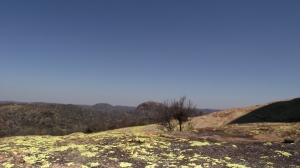Despite all the political nonsense that goes on in and around Zimbabwe, the beauty of the land remains largely unchanged. We spent a happy day visiting one of our favourite spots close to Bulawayo, the Matopos . Nothing much had changed over the years, apart from a smart new entrance gate to the National Park, and the request for a payment of US$10 a head, to enter. In days gone by we simply hopped into our cars and drove out there. I’m happy to say it was designated a World Heritage Site in 2003.
Our first stop was at the M.O.T.H. shrine, which was in reasonably good nick. On our drive up to Bulawayo I noticed that the M.O.T.H. cottages (a retirement home for old soldiers) still seemed to be in operation just outside of the small town of Essexvale / Esigodini.
The MOTH Shrine has huge trees in the gounds:
Part of the pleasure of visiting the Matopos is “just being in the bush”.
The pale blonde winter grass is harvested everywhere for use as thatching.
The ranges of hills, with their jumbled rock formations, seem to go on forever.
And of course, we paid a visit to World’s View, the burial place of Cecil John Rhodes.
He chose to be buried in the actual rock, atop a giant whaleback formation, deep in the Matopos. The ascent is steep, to say the least. I was hauled up by John and Helen, and levered down with the help of Eugene and John – thank goodness for big, strong men!
It doesn’t look so steep from the pic above, but believe me, it is! When I left Zim in 1978 I could whisk up to the top in a flash, barely out of breath; thirty years and one hip replacement later, it was quite an effort.
This must be one of the most dramatic burial places in the world.
Lichen covers many of the rocks at World’s View, in brilliant acid yellows, ochre, and orange.
And then there are the brilliantly coloured lizards that dart under the boulders
What a beautiful day it was – the Matopos is one of my favourite places. I’ve been lucky enough to see quite a bit of the world, and I think the Matopos equals the American Grand Canyon – not in size, but in inspiration, and the grandeur of its natural beauty.
Many thanks to Laura van der Merwe for her photographs.











I really enjoyed clicking on some of these photos and seeing the image up close. The fig tree is amazing- smooth bark, and is this edible figs–black or white figs..? Also the lizard is gorgeous- a rainbow lizard. The balancing rocks and the burial–all really neat to see Alison. Thanks!
LikeLike
So far as I know only the birds and the insects enjoy the fruit from these fig trees. But I could be wrong: am not that clued up about indigenous trees, I have to admit.
LikeLike
There are many types of fig tree, so took the time to try and look this one up. According to my handy book “Making the most of Indigenous Trees” by Fanie & Julye-Ann Venter, it appears to be the Common Wild Fig tree. Its smooth bark is due to its old age and they can grow up to 15m tall. Livestock eat the dry leaves on the ground, leaves and twigs are eaten by elephant, giraffe, kudu, nyala, bushbuck, impala and Damara dik-dik. Dropped fruits are eaten by baboons, vervet monkeys, mongoose, dassies, bush-pigs, warthogs and various buck. Ripe fruit, growing directly on the twigs, are eaten by bats, louries, parrots, pigeons, barbets and bulbuls. Fruit are edible and can make a good jam. An infusion of root and fibre is taken to prevent abortion. Powered root taken in porridge stops nose bleeds, milky latex is dropped in eyes to treat cataracts. An infusion of the bark prevents constipation and nose bleeds, also used for colds and throat infections. Bark fibre is used for making mats, the twined bark makes a strong rope and planks can be cut for general timber. A very useful tree indeed. Regards Laura van der Merwe
LikeLike
Wonderful, Alison. Great photos. Eileen
LikeLike
Thanks Alison – I bet there are many different types of fig trees.
LikeLike
Alison, these are not the images I have been associating with Zim in the last decade – you are showing us a world far removed from images of hunger, repression, police brutality, farm murders, rioting and looting, and general political madness.
I did not know that such beautiful places still exist. I am relieved that they do.
LikeLike
Make no mistake : all that bad stuff happened, and for all I know, perhaps it still does. But my experience was limited to visiting Bulawayo and the midlands, where I was fortunate enough to only experience the beauty of the veldt and meet some wonderful old-style Rhodesians. I’m about to post my last article on Zim, which focuses on some of the craziness.
LikeLike
ljedit–thanks for posting the details on the fig tree. Interesting and brought the tree alive for me. Native species are so valuable for animals, insects…
Fig trees don’t grow in my area-thanks again. Sher
LikeLike
This was the best place to be, I remember going there on a school trip that was in 1982, was doing my grade 4), enjoyed being out of the city centre.
LikeLike